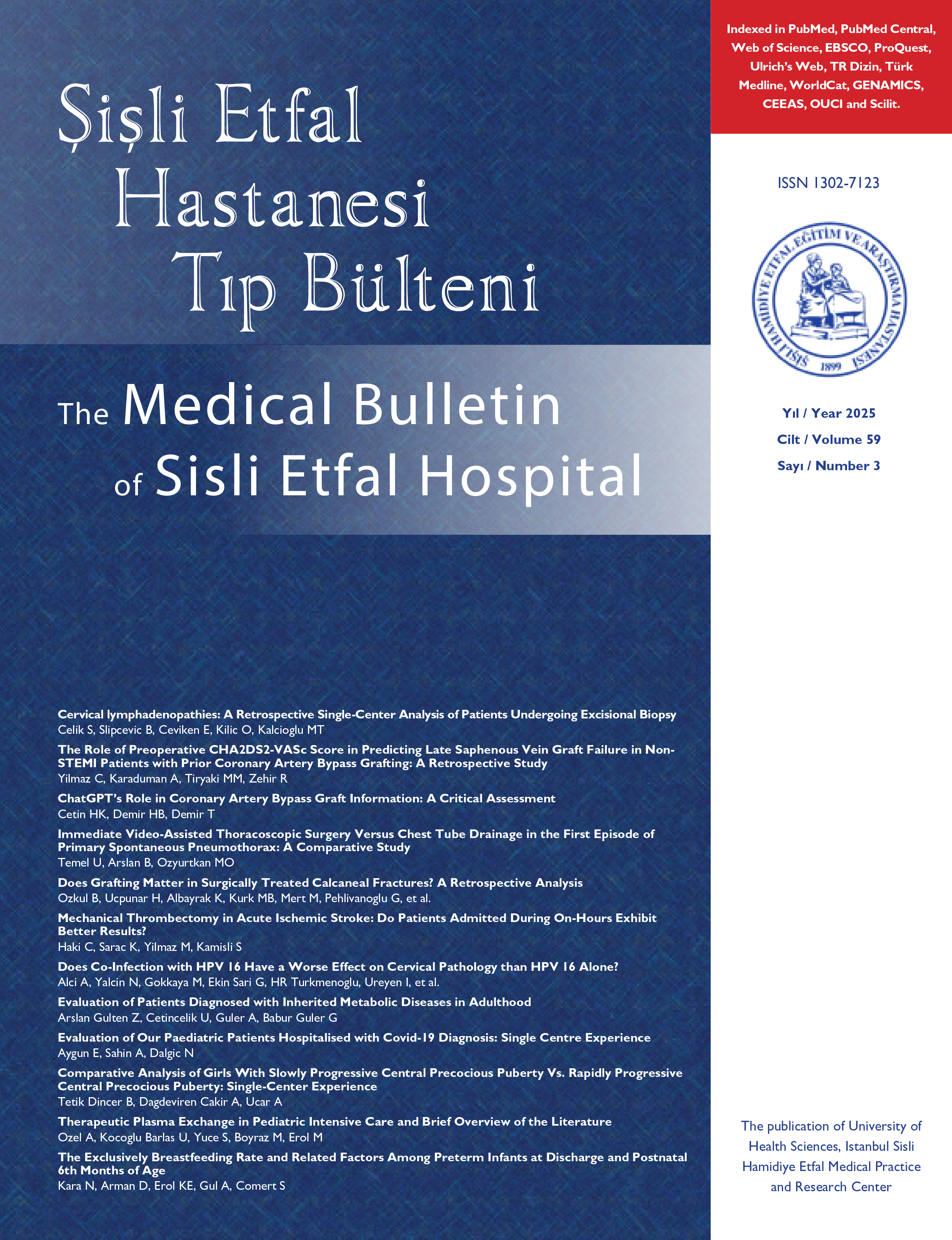
Adverse Outcomes of Preeclampsia in Previous and Subsequent Pregnancies and the Risk of Recurrence
Ulas Coban1, Taha Takmaz2, Ozge Deniz Unyeli3, Savas Ozdemir11Department of Obstetrics and Gynecology, Sisli Hamidiye Etfal Training and Research Hospital, Istanbul, Turkey2Department of Obstetrics and Gynecology, Bezmialem University Faculty of Medicine, Istanbul, Turkey
3Department of Obstetrics and Gynecology, Samsun Training and Research Hospital, Samsun, Turkey
Objectives: We evaluated the fetal and maternal outcomes of pregnant women with preeclampsia who gave birth in our hospital; we also evaluated preeclampsia recurrence rates in these patients and their fetal and maternal outcomes in their subsequent pregnancy.
Methods: In this retrospective cohort study, 126 patients whose medical records were accessed completely and who got pregnant again and gave birth in our hospital were analyzed. The primary aim was to show the recurrence rate of preeclampsia, while the secondary aim was to evaluate the maternal and fetal results of the first pregnancy in which preeclampsia developed and the subsequent pregnancy.
Results: The incidence of preeclampsia was found to be 2.1% in our clinic. The first pregnancy in which preeclampsia developed; 111 (80.2%) pregnancies resulted in a live birth, 7 (5.6%) resulted in termination, and 8 (6.3%) resulted in stillbirth. Neonatal death occurred in 10 (7.9%) pregnancies. While 105 of the subsequent pregnancies resulted in a live birth, 10 (7.9%) resulted in abortion, 9 (7.1%) resulted in stillbirth, and 2 (1.6%) resulted in termination due to preeclampsia. Neonatal death developed in 3 (2.6%) pregnancies. In the subsequent pregnancy, preeclampsia developed in 70 (55.5%) patients and 39 (55.7%) of these had preeclampsia with severe features.
Conclusion: The present study guides us on the risk factors related to preeclampsia and the rate of fetomaternal adverse outcomes and emphasizes the need for strict and regular antenatal follow-up in the subsequent pregnancies of women who have a history preeclampsia. Improvement of maternal and fetal morbidity and mortality in this way is the utmost goal.
Önceki ve sonraki gebeliklerde preeklampsinin olumsuz sonuçları ve rekürrens riski
Ulas Coban1, Taha Takmaz2, Ozge Deniz Unyeli3, Savas Ozdemir11Şişli Hamidiye Etfal Eğitim ve Araştırma Hastanesi, Kadın Hastalıkları ve Doğum Kliniği, İstanbul2Bezmialem Üniversitesi Tıp Fakültesi, Kadın Hastalıkları ve Doğum Anabilim Dalı, İstanbul
3Samsun Eğitim ve Araştırma Hastanesi Kadın Hastalıkları ve Doğum Kliniği, Samsun
Amaç: Bu çalışmada hastanemizde doğum yapmış preeklamptik gebelerin fetal ve maternal sonuçlarını değerlendirdik ayrıca bu hastalarda preeklampsi rekürrens oranlarını ve takip eden gebelikteki fetal ve maternal sonuçları değerlendirdik.
Yöntemler: Bu retrospektif kohort çalışmada medikal kayıtlarına eksiksiz ulaşılabilen, tekrar gebe kalıp hastanemizde gebeliği sonuçlanan 126 hasta analiz edildi. Birincil amaç preeklampsinin rekürrens oranını ortaya koymak ikincil amaç ise preeklampsi gelişen ilk gebelik ve bunu takip eden gebeliğin maternal ve fetal sonuçlarını değerlendirmekti.
Bulgular: Kliniğimizde preeklampsi görülme oranı %2.1 olarak tespit edildi. Preeklampsi gelişen ilk gebelikte 111 (%80.2) gebelik canlı doğum ile sonuçlanırken, 7 (%5.6) gebelik terminasyon, 8 (%6.3) gebelik de ölü doğum ile sonuçlanmıştır. Neonatal ölüm 10 (%7.9) gebelikte izlendi. Takip eden gebeliklerin 105 tanesi canlı doğum ile sonuçlanırken, 10 (%7.9) tanesi abortus, 9 (%7.1) tanesi ölü doğum ve 2 (%1.6) tanesi preeklampsi nedeniyle terminasyon ile sonuçlandı. Neonatal ölüm 3 (%2.6) gebelikte izlendi. Takip eden gebelikte hastalardan 70 (%55.5)'inde preeklampsi gelişti ve bunlardan 39 (%55.7) tanesi şiddetli preeklampsi kriterlerine sahipti.
Sonuç: Bu çalışma preeklampsi ile ilgili risk faktörleri ve fetomaternal advers sonuçların oranları konusunda bize yol gösterici olup geçirilmiş preeklampsi öyküsü olan hastaların takip eden gebeliklerinde de antenatal takibin sıkı ve düzenli olarak yürütülmesi konusuna dikkat çekmektedir. Bu şekilde maternal ve fetal morbidite ve mortalitenin iyileştirilmesi en büyük hedeftir. (SETB-2020-07-135)
Manuscript Language: English



















